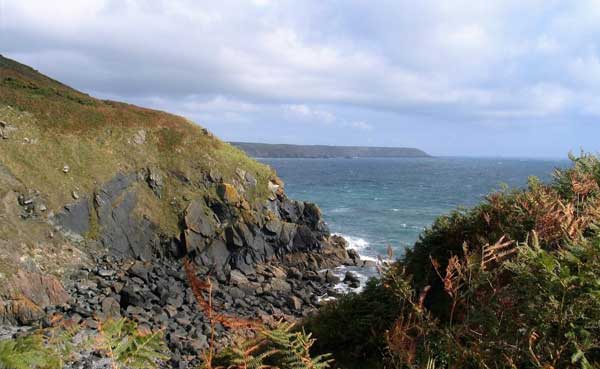Poltesco Valley

Eight Places to Eat in the Lizard
June 15, 2019
Walking from Lizard Point to Kynance Cove
June 15, 2019Poltesco Valley

The leafy greens and knotted trees of the luscious Poltesco Valley provide a soft yet striking contrast to the Lizard’s wild and rugged coastline. Ducking into this paradisaical valley, where dappled sunlight pours through the emerald canopy and a gurgling stream runs towards the sea, it’s not hard to be swept away by its magnetic appeal.
Heading along the South West Coast Path, it may be easy to overlook Poltesco, which emerging from the trees joins with Carleon Cove. But it is absolutely worth an explore as within its luscious core rests an intriguing throwback to the valley’s history. Slowly being taken over by nature under the watchful eye of the National Trust, Poltesco Valley and Carleon Cove are home to the remains of 17th century pilchard cellars and a 19th century serpentine factory.
A booming industry from the mid-18th to late 19th century, pilchard fishing played a hugely important part in the county’s economy. Often involving the efforts of whole communities, men and women alike would rally together in an effort to bring in as many fish as possible, when huge schools of pilchards would grace the waters around the end of September. From boat builders to net makers to fishermen to salters, everyone had a part to play.
Heavily involved, Carleon Cove was the site of a large fishery between the 16th and 19th centuries. Pushing out from the shore, boats would row out under the direction of a ‘huer’ on top of the cliffs and would snare hundreds upon hundreds of fish in their nets, scooping them out into baskets. Upon return with their fishy haul, the fishermen would proceed to sort their catch in the fish cellars’ square courtyard, salting the fish ready for export and using the valuable oil for lighting lamps.
As the years rolled on, Carleon Cove’s fishing industry began to break down, and was all but abandoned in Cornwall by the 1880’s. To this day, all that remains of the cellars in the cove is a round, roofless building that once housed the capstan for hauling fishing boats up the shelving beach. Far from finished though, Poltesco Valley was just about to enter its next most exciting chapter.
Repurposing many of the buildings that were used by the fisheries, the Lizard Serpentine Company built a factory in the cove in 1855. While the first written evidence of serpentine being worked dates from 1828, it wasn’t until 1846, when Prince Albert toured the serpentine works in Penzance that the demand for serpentine really kicked off. Following a display of serpentine products in the Great Exhibition of 1851, the craze began.
Making use of the Lizard’s bountiful supply of the otherwise rare rock, the Lizard Serpentine Company cut and polished the stone to achieve great effect. Showcasing the beautiful and unusual reds, greens and greys endemic to the Lizard stone, serpentine was worked into trinkets, ornaments and even structural pieces creating unique, aesthetic products. Following their success, a showroom, warehouse and offices were later opened in Carleon Cove, as well as a showroom on the Strand in London which featured a 2.3m serpentine vase.
Sourcing serpentine from local quarries, the Lizard Serpentine Company would craft their magic before transporting finished items in flat-bottomed barges to offshore schooners. Initially using a waterwheel before changing to a steam engine, the remains of the factory’s chimney stand proud in the cove today, alongside the forge walls, old workshops and wheel pit. The keen eyed among you will even be able to spot the initials LSC carved into one of the buildings!
Falling foul of the fickle nature of trends as well as the unpredictable and ruthless nature of the sea, the Lizard Serpentine Company faced heightening economical strain from increasing transportation costs, diminishing resources, uninsured losses at sea and competition from the cheaper, increasingly more popular marble stone. As well as this, serpentine proved not particularly durable in urban air, susceptible to cracking and erosion. Eventually, the factory wound up in 1870, and after briefly relaunching as the Poltesco Marble Company, closed for good in 1893.
These days, Poltesco Valley and Carleon Cove offer a veritable time capsule, unpretentious beauty and somewhere wonderful for exploring, reflecting and simply sitting and admiring the views.


